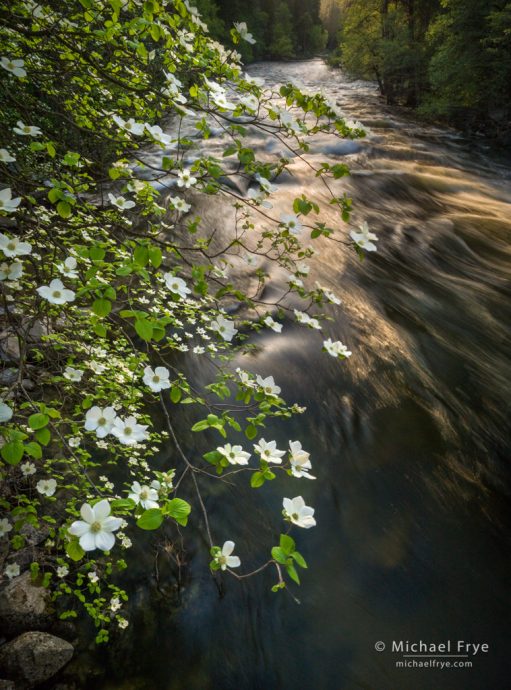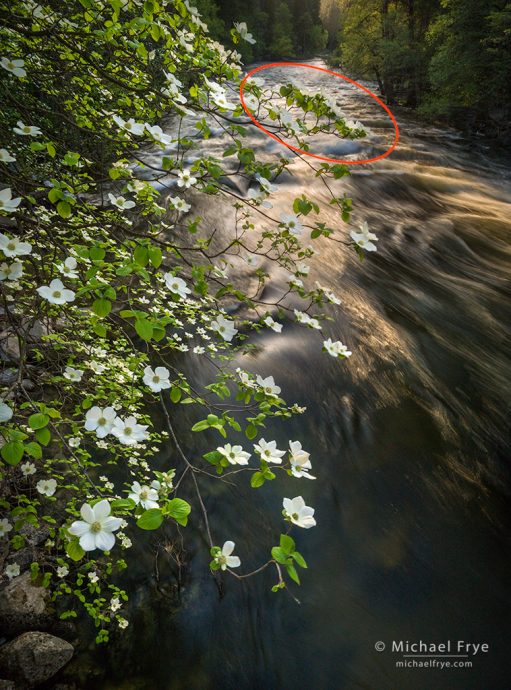
Dogwood and late-afternoon light along the Merced River, Yosemite
While the big wildflower blooms in southern California are now well past peak, spring keeps progressing into cooler regions, like the mountains. It’s been a good year for dogwoods, and Claudia and I have had a few opportunities to photograph them over the last couple of weeks.
Most of my dogwood photographs have been made with telephoto lenses in soft light. The scene above didn’t fit that description at all, with a close foreground that seemed to demand a wide-angle lens, and late-afternoon sunlight streaming down the river, creating lots of contrast. But the backlight looked beautiful – and besides, I’ve photographed dogwoods many times, so I was in the mood to push myself and do something different.
The biggest problem was finding the right camera position. Take a close look at the composition above and imagine what would happen if I had moved the camera to the left, or right, or up, or down.
My biggest concern was the diagonal clump of dogwood blossoms near the top of the frame (circled in red below). If the camera was lower that clump would merge, visually, into the river bank above. If the camera was further left that clump would merge into the river bank on the right. A higher camera position would have created a merger between the single blossom that’s above and to the left of the clump and the edge of the water. Moving the camera further right would have left too much space between that clump and the bank on the right.

When choosing the camera position my biggest concern was the clump of flowers circled in red.
There seemed to be only one ideal camera position. Since that spot was well over my head I had to raise the tripod as high as possible and use the camera’s LCD screen to compose.
Then I popped the camera off the tripod, added filters (a polarizer and a seven-stop ND), rotated the polarizer, focused, and adjusted my shutter speed, aperture, and ISO. With the camera back on the tripod I found a rock to stand on so I could reach up and shade the lens with my hand to eliminate lens flare.
Then I made a series of at least 20 exposures with identical settings (0.7 seconds at f/16, ISO 100). Why capture all those frames with the same settings? Because I knew the water would look different in each one, and some would be better than others. The image at the top of this post had, to my eye, the most interesting water textures.
Camera placement is the first – and often most important – decision you make when composing a photograph. If you get the camera in the right position then you just have to figure out what to include in the frame from that position.
Yes, there are times when the exact camera position doesn’t matter much. If everything in the scene you’re photographing is distant, then moving the camera a couple of feet in one direction or another won’t make a noticeable difference. But if you’re close to your subject then finding the best camera position is vital. An inch could make a big difference.
— Michael Frye
Related Posts: Knowing Where to Stand; Patterns, Focal Points, and Flowers
Michael Frye is a professional photographer specializing in landscapes and nature. He is the author or principal photographer of The Photographer’s Guide to Yosemite, Yosemite Meditations, Yosemite Meditations for Women, Yosemite Meditations for Adventurers, and Digital Landscape Photography: In the Footsteps of Ansel Adams and the Great Masters. He has also written three eBooks: Light & Land: Landscapes in the Digital Darkroom, Exposure for Outdoor Photography, and Landscapes in Lightroom: The Essential Step-by-Step Guide. Michael has written numerous magazine articles on the art and technique of photography, and his images have been published in over thirty countries around the world. Michael has lived either in or near Yosemite National Park since 1983, currently residing just outside the park in Mariposa, California.









Camera position is definitely a very important and involved aspect of the photographic process. The short lesson learnt here will surely help in composing relevant photos. Thank you for this article 🙂
Thanks Surya!
I’ve said many times, “the best way to take a beautiful picture is to stand in front of something beautiful and take it’s picture.”
Excellent post.
Thanks Mike. I’m not sure about that; there are millions of people who have stood in front of something beautiful like, say, Tunnel View, and taken mediocre snapshots!
Yes exactly…I like to start with an exposure, review, change my angle, position etc.. take another… Repeat. It’s a learning process. Does anyone ever truly matter composition? Great post Michael
I meant to say does anyone truly ever master composition 🙂
Yeah, I figured. 🙂 Thanks Nelson!
Beautiful picture, Michael! Especially love the light on the water.
Thanks Gabor!
Gorgeous photo and great explanation of your thought process behind it.
Thank you Heather!
Hi Michael,
I like that the blossoms appear still during the long exposure. This seems like a silly question: Are you blending some of the exposures to achieve this? That seems like a perfectly reasonable approach to achieve this.
I’m also curious about the positioning of your tripod. Were any of the legs in the moving water?
Thanks Sean. No, I didn’t blend exposures, but blending is a possibility when the branches won’t hold still but you want a long exposure. You can, in theory, push up the ISO and take a shorter exposure for the branches, then blend that with a longer exposure for the water.
But in practice, blending is really problematic when the branches are in front of water. You have one image with sharp branches, and another with blurred branches where the branches are actually in a different position than the sharp ones (because they’re moving and swaying back and forth). Let’s say the slow shutter speed image is the bottom layer, and the faster shutter speed image with the sharp branches is the top layer. If you make a mask for the top layer where the mask is white for the branches, but black everywhere else, then most of the blurry branches from the bottom layer will show through, because they’re in a different position. You’d have to actually clone out the blurry branches from that bottom layer first, which would be quite challenging with textured water like that. And making a precise mask for the branches would also be challenging in itself. In other words, no thanks! Too much work.
My tripod was on solid ground well above the water.
Thank you for the post regarding camera position! I truly enjoy reading the posts about composition. Fabulous shot!
Thanks Carol – glad you like this post!
Great image Michael, I would have never known of the clumps you mention. I don’t see any distraction in the shot, but I do see what you mean by different camera position for the best angle.
Thanks Randy. If some of the branches and blossoms merged with the riverbanks on the top or right that wouldn’t be distracting, necessarily, but the image wouldn’t “read” as well. In other words, the branches wouldn’t stand out as clearly, and the image would become visually confusing and messy. The photograph is actually pretty complex, because I was trying to make a lot of different elements work together, so anything that can make it simpler and read better helps a lot.
Wonderful image, Michael!!
Thanks Bill!